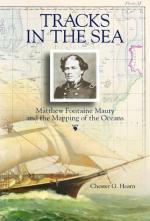|
This section contains 351 words (approx. 2 pages at 300 words per page) |
World of Scientific Discovery on Matthew Fontaine Maury
Matthew Fontaine Maury was born near Fredericksburg, Virginia, in 1806, and entered the Navy at age eighteen. By age twenty-four he had circumnavigated the world and six years later published A New Theoretical and Practical Treatise on Navigation, which the Navy adopted as a textbook.
An unfortunate stagecoach accident in 1839 left him permanently handicapped and forced him to retire from active duty. He accepted a position as superintendent of the Depot of Charts and Instruments at Washington. Later, he became superintendent of the United States Naval Observatory. During this time he threw himself into the study of ocean winds and currents. Maury's studies were facilitated by giving ship captains specially prepared logbooks so that data might be accurately obtained for his work. One of his first projects was to continue the work of Benjamin Franklin, who began a study on the Gulf Stream. Maury gave the Gulf Stream its now-popular description "A River in the Ocean."
With the data obtained from ship logs on ocean wind and currents, Maury published Wind and Current Chart of the North Atlantic, which was followed by supplementary sailing directions in later years. This work was highly acclaimed because it helped navigators plot more efficient ocean voyages, and captains learned to take advantage of ocean currents instead of resisting them.
Many of Maury's achievements helped earn him the title "father of oceanography." In 1855 he published the first textbook of modern oceanography called The Physical Geography of the Sea. He was also consulted to help determine where to set the world's first transatlantic telegraph cable, called the Atlantic cable. By charting ocean depths, he helped persuade the public that such a project was feasible. While working on this project, he noted that the Atlantic Ocean was more shallow in the middle than at its edges closer to the coasts. This fact led to the later discovery of the Mid-Atlantic Ridge.
In 1861 Maury resigned from the United States Navy to join the Confederacy, but after the war he returned to the field of science, ending his career as a professor of meteorology at the Virginia Military Institute.
|
This section contains 351 words (approx. 2 pages at 300 words per page) |


